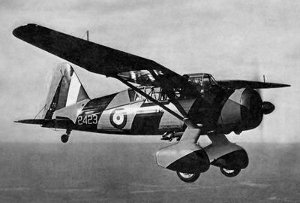Topic: RCAF

Bristol 149 Bolingbroke, see full image at the Canadian Museum of Flight website.
Made-in-Canada Planes For the Canadian Force
Ottawa Citizen, 22 November, 1939
Two of the Several Types of Machines That Will Make Up Dominion's Air Equipment Viewed at Rockecliffe Airport. The Bolingbroke Bomber and the Lysander Reconnaissance Planes Accepted.
Two of the several types of machines that will make up Canada's fighting and reconnaissance air armada were viewed by members of the press at Ottawa Air Station of the Royal Canadian Air Force yesterday afternoon. Major Thomas Wayling, press liaison officer of the Department of National Defence arranged the visit and writers and photographers were received at the station by Squadron Leader A.J. Ashton, commanding officer.

Westland Lysander
The machines were the Bristol Bolingbroke and the Westland Lysander. The Bolingbroke is a bomber of British design and made in Canada. The Lysander is a reconnaissance craft but is equipped with machine guns and can also carry bombs. It is also made in Canada.
Demonstrates Bolingbroke
Squadron Leader Lawrence Wray gave the visitors a brief demonstration of the Bolingbroke, on one occasion zooming past one of the hangers at 265 miles per hour. This is by no means the top speed of this sleek machine, which has been camouflaged for obvious reasons. The Lysander also wears a coat of camouflage. Various advantages of both craft were explained to the visitors.
Another Milestone
Delivery to an acceptance by the Royal Canadian Air Force on Friday of last week of the first Bristol Bolingbroke aircraft manufactured in Canada is another milestone in the development os the aircraft industry in this Dominion.
This bomber reconnaissance version of the Bristol Blenheim, which is a twin-engined high-performance day and night bomber, is the first of eighteen for which the Fairchild Aircraft, Limited, at Longueuil, Que., received an order.
Crew of Four
Although the Blenheim was provided with accommodation for a crew of three, that of the Bolingbroke is enabled to carry a crew of four, together with a camera mounting. Compensation for the additional weight is in part provided by a reduction in the number of bombs, which are carried internally in a bomb-cell under the center section of the aircraft.
The Royal Canadian Air Force establishment makes provision for a number of bomber reconnaissance squadrons.
Order 28 Planes
Army co-operation squadrons of the Royal Canadian Air Force are now being equipped with Westland two-seat army co-operation high-wing monoplanes. An order for twenty-eight of these aircraft was placed with the National Steel car Corporation, Limited, and a number of these have already been delivered to the R.C.A.F. from the factory established at Malton, Ont., and adjoining Toronto's inland terminal airport.
This aircraft represents the result of many years' experience secured by army co-operation pilots and is now in quantity production for the Royal Air Force. The cockpit is located in front of and level with the leading edge of the wings, which provides the pilot with an exceptional view desirable for spotter and reconnaissance duties.
Since this type of aircraft is often obliged to operate from temporary and confined landing grounds, the Lysander has been given a remarkably quick take-off, a low landing speed and a steep climb. The wings incorporate Handley Page wing tip and root slots and trailing edge slotted flaps, whose operation is entirely automatic. This assists in the retention of control at slow speeds, necessary for close co-operation and camera duties.
The Westland Lysander aircraft being built in Canada are powered with the Bristol Perseus XII sleeve valve engine, the maximum output of which is 905 horsepower at 6.500 feet. Great Britain is the only country in the world producing these engines, advantages claimed for which are less noise, lower fuel consumption, easier maintenance, fewer and simpler parts, reduced wight, minimum risk of fire and simpler manufacture. The Guggenheim Gold Medal for the most outstanding contribution to aeronautical progress, was presented to Mr. A.H.R. Fedden, who perfected the design of this engine.
